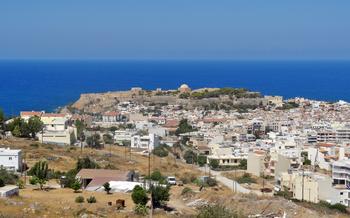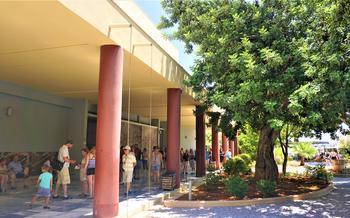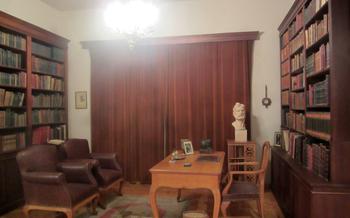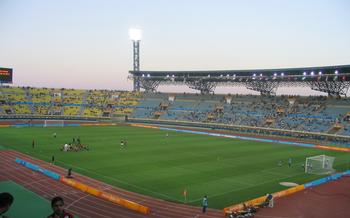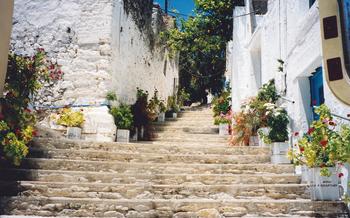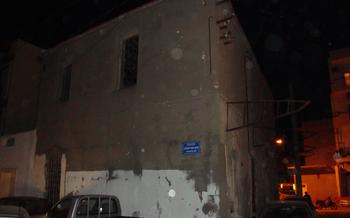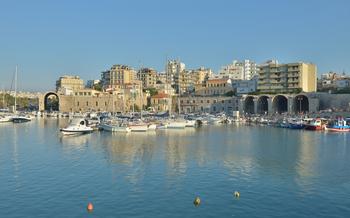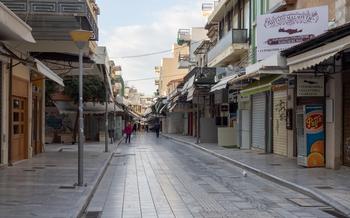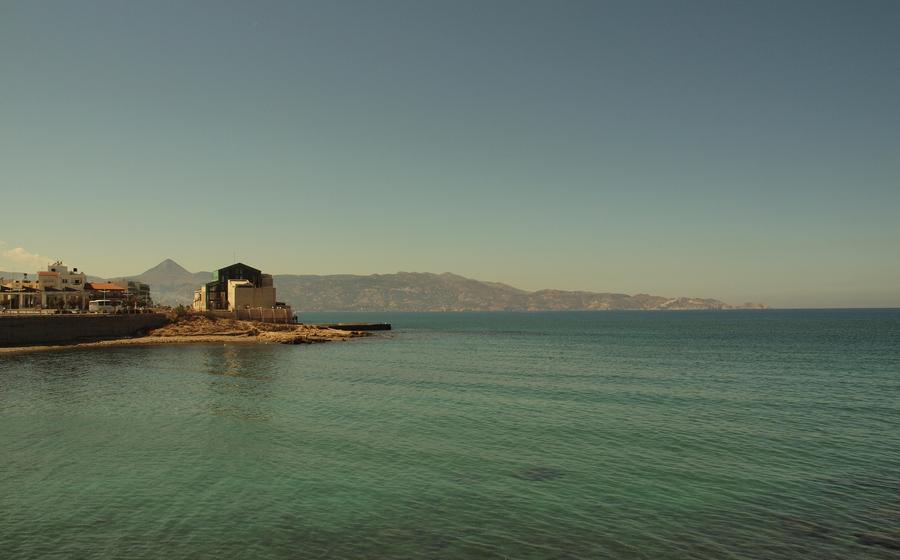
Natural History Museum of Crete
- The Natural History Museum of Crete: An Overview
- Exploring the Museum's Collections
- Highlights of the Fossil Collection
- A Journey Through Time and Ancient Life
- Discovering the Marine Life Gallery
- Plant Life and Biodiversity
- Temporary Exhibitions and Events
- Educational Programs for Visitors
- Research and Conservation Initiatives
- Museum Shop and Publications
- Accessibility and Facilities
- Photography and Social Media
- Nearby Attractions and Points of Interest
- Volunteering and Internship Opportunities
- Tips for a Rewarding Visit
- Insider Tip: Hidden Gems and Secret Spots
The Natural History Museum of Crete: An Overview
Heraklion, the capital of Crete, is home to a wealth of natural wonders and historical treasures. Among them, the Natural History Museum of Crete stands out as a must-visit destination for anyone interested in exploring the island's rich biodiversity and geological heritage. Established in 1981, the museum has become a leading institution for natural history research and conservation in the Mediterranean region.
Located in the heart of Heraklion, the museum is easily accessible by public transportation or on foot from the city center. Its impressive collection includes fossils, marine life specimens, and exhibits on the island's flora and fauna, providing a comprehensive overview of Crete's natural history. The museum is open to the public daily, with guided tours available in multiple languages.
Beyond its captivating exhibits, the Natural History Museum of Crete plays a crucial role in scientific research and conservation efforts. The museum's team of experienced researchers conducts studies on various aspects of Crete's natural history, contributing to the understanding and preservation of the island's unique ecosystems.
Admission fees to the museum are affordable, and discounts are available for students, seniors, and families. The museum also offers a range of educational programs for school groups and families, making it an ideal destination for learning and discovery.
Exploring the Museum's Collections
The Natural History Museum of Crete boasts a diverse array of exhibits that take visitors on a journey through the island's rich natural heritage. From awe-inspiring fossils that tell the story of ancient life to captivating displays of marine biodiversity, the museum offers a comprehensive exploration of Crete's unique ecosystems.
Thematic galleries showcase various aspects of Crete's natural history, providing visitors with an in-depth understanding of the island's geology, flora, and fauna. Interactive displays and educational resources cater to visitors of all ages, making learning about the natural world both enjoyable and accessible.
Guided tours and workshops are available for those seeking a more immersive experience. Led by knowledgeable naturalists and educators, these programs offer an insider's perspective on the museum's collections and research. Whether you're a casual visitor or a passionate naturalist, the Natural History Museum of Crete has something to offer everyone.
Highlights of the Fossil Collection
A Journey Through Time and Ancient Life
The Natural History Museum of Crete boasts an impressive collection of fossils that transport visitors back in time to explore the island's rich geological history. Among the notable specimens are the fossilized remains of ancient animals, such as the Deinotherium, a massive elephant-like creature with tusks that curved downwards, and the Hippopotamus creutzburgi, a dwarf hippopotamus that roamed Crete during the Pleistocene epoch. The museum also houses a collection of fossilized plants, including leaves, seeds, and pollen, which provide valuable insights into the evolution of Crete's flora over millions of years.
These fossils are not merely static displays; they are gateways to understanding the dynamic processes that have shaped Crete's landscape and biodiversity. Through the study of fossils, scientists can piece together the history of life on the island, from the emergence of the first organisms to the arrival of humans. Fossils also provide clues about past climates and environmental conditions, helping us to understand how Crete's ecosystems have evolved over time.
The museum's paleontological collection is not only a treasure trove for researchers but also a captivating attraction for visitors of all ages. Through interactive displays and educational resources, the museum brings the ancient world to life, fostering a sense of wonder and curiosity about the natural history of Crete.
Discovering the Marine Life Gallery
Immerse yourself in the captivating world of Crete's marine ecosystems at the Natural History Museum of Crete. The Marine Life Gallery is a treasure trove of wonders, showcasing the island's rich biodiversity and the diverse array of creatures that call its waters home.
Interactive displays bring the underwater world to life, allowing visitors to explore the intricate relationships between marine organisms and their environment. Learn about the unique adaptations that enable these creatures to thrive in the Mediterranean Sea, from the camouflage techniques of seahorses to the powerful jaws of moray eels.
Discover the importance of marine conservation for the health of Crete's coastal environment. Interactive exhibits highlight the threats faced by marine life, such as pollution, overfishing, and climate change. Visitors are encouraged to become advocates for the ocean and take action to protect its delicate ecosystems.
The Marine Life Gallery is a captivating journey into the depths of Crete's underwater realm. Whether you're a seasoned diver, a marine enthusiast, or simply curious about the wonders of the sea, this gallery is sure to captivate and inspire.
Plant Life and Biodiversity
The Natural History Museum of Crete also showcases the diverse flora of the island. Crete is home to a wide variety of plant species, many of which are endemic to the island. The museum's exhibits highlight the unique adaptations of these plants to the island's diverse habitats, ranging from coastal dunes to alpine meadows. Visitors can learn about the role of plants in the island's ecosystems, including their importance as food and shelter for animals, and their role in soil conservation and water filtration.
Exhibits also explore the traditional uses of plants in Cretan culture. For centuries, Cretans have relied on plants for food, medicine, and other purposes. The museum showcases the many ways in which plants have been integrated into Cretan cuisine, traditional remedies, and handicrafts. Visitors can learn about the cultural significance of plants, such as the use of herbs in cooking and the use of flowers in religious ceremonies.
The museum also highlights the importance of conservation efforts to protect endangered plant species. Crete is home to a number of threatened and endangered plants, due to factors such as habitat loss, climate change, and invasive species. The museum works in collaboration with other organizations to raise awareness about the importance of plant conservation and to implement conservation measures to protect these valuable species.
Temporary Exhibitions and Events
The Natural History Museum of Crete regularly hosts temporary exhibitions and special events that showcase new research, discoveries, and collaborations. These exhibitions provide visitors with an opportunity to delve deeper into specific aspects of natural history and learn about the latest findings in various fields.
To stay updated on upcoming exhibitions and events, visitors can check the museum's website or follow its social media channels. The museum also offers educational programs and workshops in conjunction with its temporary exhibitions, providing a more in-depth experience for school groups, families, and individuals.
Temporary exhibitions play a crucial role in the museum's mission to promote scientific literacy and conservation awareness. They allow the museum to showcase new research findings, highlight pressing environmental issues, and engage with a broader audience. By participating in these events, visitors can gain valuable insights into the latest developments in natural history and contribute to the museum's ongoing efforts to protect and preserve Crete's natural heritage.
Educational Programs for Visitors
The Natural History Museum of Crete offers a wide range of educational programs designed to engage and inspire visitors of all ages. These programs provide opportunities for school groups, families, and individuals to learn more about the natural history of Crete and the importance of conservation.
School Programs:
The museum offers guided tours, workshops, and interactive activities tailored to different grade levels. These programs align with school curricula and focus on topics such as biodiversity, evolution, and the environment. Students can explore the museum's exhibits, conduct hands-on experiments, and engage in discussions with experienced educators.
Family Programs:
Families can participate in fun and educational workshops and activities designed to spark curiosity and foster a love for nature in children. These programs often include storytelling, crafts, and interactive games that teach about different aspects of natural history. Families can explore the museum together and create lasting memories.
Booking Educational Tours and Workshops:
To book educational tours or workshops, schools and families can contact the museum's education department in advance. The museum staff will work with educators to customize programs based on specific needs and interests. Reservations are recommended to ensure availability.
Promoting Scientific Literacy and Conservation Awareness:
Through its educational programs, the Natural History Museum of Crete aims to promote scientific literacy and raise awareness about the importance of conservation. By engaging visitors with interactive learning experiences, the museum encourages critical thinking, problem-solving skills, and a deeper understanding of the natural world. These programs inspire future generations to become stewards of the environment and contribute to the conservation of Crete's unique biodiversity.
Research and Conservation Initiatives
The Natural History Museum of Crete actively engages in scientific research and conservation projects, contributing to the preservation of Crete's natural heritage. Collaborating closely with universities, research institutions, and conservation organizations, the museum plays a pivotal role in advancing our understanding of the island's biodiversity.
Researchers associated with the museum conduct field studies, collect data, and analyze specimens to contribute to a comprehensive understanding of Crete's flora and fauna. Their work focuses on various aspects, including the distribution and ecology of species, the impact of climate change and human activities on ecosystems, and the identification of threatened or endangered species.
The museum also actively participates in conservation initiatives aimed at protecting Crete's natural environment. These initiatives include habitat restoration projects, reforestation efforts, and public awareness campaigns. The museum collaborates with local communities, government agencies, and conservation organizations to implement these projects and promote sustainable practices.
One of the museum's ongoing research projects focuses on the conservation of the critically endangered Cretan wild goat (Capra aegagrus creticus). This project involves monitoring the goat's population, studying its habitat, and raising awareness about the threats it faces.
Through its research and conservation initiatives, the Natural History Museum of Crete plays a vital role in preserving the island's unique natural heritage for future generations.
Museum Shop and Publications
The Natural History Museum of Crete houses a well-stocked museum shop that offers a diverse range of unique souvenirs and educational resources for visitors of all ages. From fossils and minerals to wildlife-themed toys and books, the shop provides an opportunity to take home a piece of the museum's treasures.
The museum's publications, including scientific journals, books, and guides, are available for purchase at the shop. These publications showcase the museum's research findings and contribute to the dissemination of scientific knowledge. By purchasing these publications, visitors can support the museum's mission and stay up-to-date with the latest discoveries in the field of natural history.
The museum shop plays a vital role in supporting the museum's educational and research initiatives. A portion of the proceeds from sales is directed towards funding exhibitions, research projects, and educational programs. By making a purchase at the museum shop, visitors can directly contribute to the museum's mission to conserve and promote the natural heritage of Crete.
Accessibility and Facilities
The Natural History Museum of Crete is committed to creating an inclusive and welcoming environment for all visitors. The museum is wheelchair accessible, with ramps and elevators providing access to all levels of the building. Accessible restrooms are also available.
For visitors with visual impairments, the museum offers tactile exhibits and audio guides. Visitors with hearing impairments can request sign language interpreters or assistive listening devices.
The museum also provides a variety of amenities to make your visit more enjoyable. A cafeteria offers a selection of snacks and beverages, and a gift shop sells souvenirs and educational resources. Restrooms are located on each floor of the museum, and there is ample parking available.
If you have any specific accessibility needs, please contact the museum in advance. The staff will be happy to assist you in planning your visit.
Tips for planning a visit with accessibility needs:
- Contact the museum in advance to inquire about specific accessibility features and to request any necessary accommodations.
- Arrive early to avoid crowds and to have more time to explore the museum at your own pace.
- Take advantage of the museum's assistive devices, such as wheelchairs, audio guides, and sign language interpreters.
- Ask the museum staff for assistance if you need help navigating the exhibits or finding accessible restrooms.
Photography and Social Media
At the Natural History Museum of Crete, capturing the wonder of the exhibits through photography is encouraged. Visitors are welcome to take pictures and share their experiences on social media, using the official hashtags and tagging the museum. The museum's social media channels (@NHMCrete) provide a platform for sharing stunning photographs, engaging with fellow enthusiasts, and learning more about the museum's ongoing projects and discoveries. By sharing your experiences online, you become part of a vibrant community of nature lovers and contribute to promoting the museum's mission to inspire and educate.
Nearby Attractions and Points of Interest
The Natural History Museum of Crete is strategically located in the heart of Heraklion, surrounded by a wealth of other attractions and landmarks that beckon visitors to explore the city's rich cultural and historical tapestry. A short walk from the museum, visitors can immerse themselves in the labyrinthine streets of the Old Town, where Venetian fortifications, Ottoman mosques, and Byzantine churches stand as testaments to Heraklion's diverse past.
Must-see attractions include the imposing Venetian Walls, the iconic Morosini Fountain, and the historical Loggia, which once served as the city's administrative center. For those seeking a deeper understanding of Crete's history and culture, the Heraklion Archaeological Museum, just a stone's throw from the Natural History Museum, houses a world-renowned collection of Minoan artifacts, including the enigmatic Phaistos Disc and the exquisite frescoes from the Palace of Knossos.
Beyond the city center, visitors can embark on a scenic journey to nearby Knossos, the legendary birthplace of the Minoan civilization. Explore the sprawling ruins of the Minoan palace, marvel at the intricate frescoes, and unravel the mysteries of this ancient civilization that flourished over 4,000 years ago.
Combine your visit to the Natural History Museum with these nearby attractions to create a comprehensive and unforgettable itinerary that unveils the many facets of Heraklion's cultural heritage. Embrace the opportunity to delve into the depths of Crete's natural and historical wonders, leaving you with an enduring appreciation for the island's rich and diverse legacy.
Volunteering and Internship Opportunities
The Natural History Museum of Crete offers a variety of volunteering and internship opportunities for individuals passionate about natural history and conservation. Volunteering at the museum is a rewarding experience that allows individuals to contribute to the museum's mission and make a positive impact on the community. Volunteers can assist with various tasks, such as leading educational programs, conducting research, or assisting with museum operations.
Internships at the museum provide students with hands-on experience in the field of natural history. Interns work closely with museum staff on research projects, exhibit development, and educational programming. Internships are available for both undergraduate and graduate students, and they offer a unique opportunity to gain valuable experience and knowledge in the field of natural history.
To learn more about volunteering or internship opportunities at the Natural History Museum of Crete, please visit the museum's website or contact the museum's education department.
Tips for a Rewarding Visit
To make the most of your visit to the Natural History Museum of Crete, consider the following tips:
-
Plan your visit for the off-season or weekdays to avoid crowds and have a more relaxed experience.
-
Start your visit with the museum's orientation film to get an overview of the exhibits and learn about the history of the museum.
-
Allow at least two to three hours for your visit to fully explore the museum's exhibits and collections.
-
Take your time and read the informative panels accompanying each exhibit to gain a deeper understanding of the natural history of Crete.
-
Engage with the interactive displays and educational resources to make your visit more interactive and memorable.
-
Join a guided tour or workshop for a more in-depth experience and to learn from the museum's experts.
-
Don't miss the museum shop for unique souvenirs and educational resources related to the natural history of Crete.
Insider Tip: Hidden Gems and Secret Spots
Beyond the main galleries, the Natural History Museum of Crete holds hidden gems and secret spots that offer a unique and immersive experience. One such gem is the fossil preparation lab. Located behind the scenes, this lab provides a glimpse into the fascinating world of paleontology. Visitors can observe paleontologists meticulously cleaning, repairing, and cataloging fossil specimens. It's a rare opportunity to witness the behind-the-scenes work that goes into preserving Crete's rich fossil heritage.
Another hidden gem is the herbarium, which houses a vast collection of pressed plants from Crete and the surrounding region. This treasure trove of botanical specimens is a valuable resource for researchers and naturalists. Visitors can admire the intricate beauty of dried flowers, leaves, and stems, and learn about the diversity of plant life on the island.
Finally, don't miss the museum's rooftop terrace. This secluded spot offers panoramic views of Heraklion and the surrounding mountains. It's the perfect place to relax and reflect on the wonders of nature you've just experienced. Whether you're a seasoned museum-goer or a first-time visitor, taking the time to explore the hidden gems of the Natural History Museum of Crete will reward you with unforgettable experiences and a deeper appreciation for the island's natural heritage.

